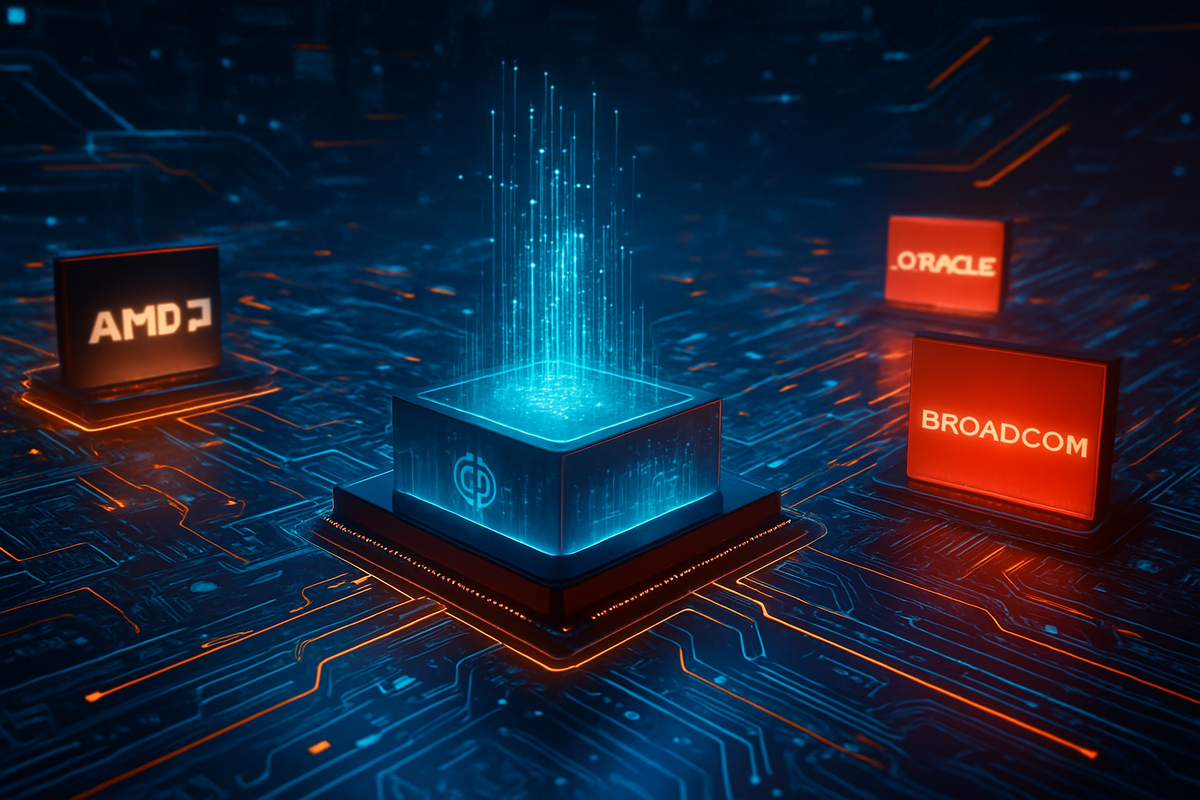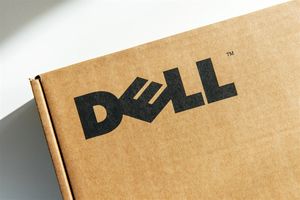
The landscape of artificial intelligence infrastructure is undergoing a seismic shift, marked by unprecedented collaborations aimed at diversifying chip supply and accelerating AI capabilities. Recent announcements highlight a significant push by industry titans, with Advanced Micro Devices (AMD) partnering with Oracle (NYSE: ORCL) for a massive deployment of its MI450 AI chips, and OpenAI embarking on a strategic alliance with Broadcom (NASDAQ: AVGO) to co-develop custom AI accelerators. These partnerships, revealed in mid-October 2025, signal a new era of competition and innovation, promising to reshape how AI models are trained and deployed on a global scale.
The immediate implications are profound: a clear intent by major AI players to reduce reliance on single-source suppliers, a pivot towards highly specialized hardware, and an infrastructure build-out of staggering proportions. As the race for AI supremacy heats up, these strategic moves are setting the stage for a more diversified, efficient, and powerful AI ecosystem, though the full impact will unfold over the coming years.
Unpacking the Megadeals: A Closer Look at Strategic Alliances
The core of this AI infrastructure revolution lies in two distinct yet interconnected strategic partnerships. First, Oracle Cloud Infrastructure (OCI) is set to integrate a colossal 50,000 of AMD's next-generation Instinct MI450 AI accelerators. This deployment, scheduled to commence in the third quarter of 2026 with further expansion into 2027 and beyond, aims to establish publicly available AI superclusters. These superclusters will leverage AMD's advanced "Helios" rack design, featuring next-generation Zen 6 Epyc CPUs ("Venice") and Pensando "Vulcano" DPUs, all engineered for high performance, scalability, and energy efficiency. Each AMD Instinct MI450 Series GPU is designed to offer up to 432 GB of HBM4 memory and a staggering 20 TB/s of memory bandwidth, enabling the training of AI models up to 50% larger than previous generations entirely in-memory. This move positions Oracle as a formidable player in providing robust AI computing resources.
Adding another layer to AMD's expanding influence, OpenAI has also forged a multi-year agreement with the chipmaker. This broader deal will see OpenAI acquire and deploy 6 gigawatts of AMD's AI accelerators, including a 1-gigawatt deployment in 2026. This significant commitment is underscored by AMD issuing OpenAI a warrant for up to 160 million shares, representing an estimated 10% stake in AMD contingent on specific share-price milestones. This equity stake ties OpenAI's success directly to AMD's, creating a powerful incentive for collaboration and innovation.
In a parallel and equally impactful development, OpenAI announced on October 13, 2025, a multi-year strategic collaboration with Broadcom to co-develop and deploy custom AI accelerators. This partnership signifies OpenAI's ambitious move towards greater control over its AI hardware stack, aiming to deliver 10 gigawatts of custom AI accelerators. Under this agreement, OpenAI will lead the design of these custom accelerators and their associated systems, while Broadcom will handle the development, production, and deployment, providing its comprehensive portfolio of Ethernet, PCIe, and optical connectivity solutions. The primary goal is to embed OpenAI's learnings from developing frontier AI models directly into the hardware, unlocking new levels of capability, intelligence, and efficiency. This strategic pivot also aims to reduce OpenAI's reliance on off-the-shelf chips from traditional suppliers. The deployment of these custom chips is projected to begin in late 2026 and be fully rolled out by the end of 2029. Reports also indicate OpenAI's collaboration with Arm to develop a central processing unit (CPU) chip designed to complement the Broadcom-designed AI server chip. While financial terms were not disclosed, Broadcom will not be taking an equity stake in OpenAI.
The Shifting Tides: Who Stands to Gain or Lose?
These monumental partnerships will undoubtedly reshape the competitive landscape of the AI chip market, creating clear winners and presenting significant challenges for others.
Winners:
- Advanced Micro Devices (NASDAQ: AMD): AMD emerges as a major beneficiary, solidifying its position as a credible alternative to the incumbent market leader. The Oracle deal provides a massive revenue stream and validates the performance of its MI450 chips. The OpenAI partnership, particularly the equity stake, aligns AMD directly with one of the most innovative forces in AI, promising long-term growth and strategic insight.
- Broadcom (NASDAQ: AVGO): Broadcom makes a significant entry into the custom AI chip arena, leveraging its expertise in development, production, and connectivity solutions. This collaboration with OpenAI positions Broadcom at the forefront of highly specialized AI hardware, opening new market opportunities and diversifying its portfolio beyond traditional networking and broadband.
- Oracle (NYSE: ORCL): Oracle significantly enhances its Oracle Cloud Infrastructure (OCI) offerings with state-of-the-art AI capabilities. By deploying 50,000 MI450 GPUs, Oracle can provide powerful and scalable AI superclusters, attracting more enterprises and AI developers to its cloud platform and strengthening its competitive stance against rivals like Amazon Web Services and Microsoft Azure.
Challenged/Potential Losers:
- Nvidia (NASDAQ: NVDA): While still dominant, Nvidia faces intensified competition. The strategic moves by Oracle and OpenAI to diversify their AI chip supply directly challenge Nvidia's near-monopoly. As more major players invest in alternative and custom solutions, Nvidia may experience pressure on its market share and pricing power in the long run.
- Intel (NASDAQ: INTC): Intel, which has been striving to gain traction in the AI accelerator market, faces further pressure. With AMD and Broadcom securing major design wins and strategic partnerships, Intel's path to becoming a significant player in high-end AI training chips becomes even more challenging.
These shifts will force all players to innovate faster, optimize their offerings, and potentially reconsider their market strategies to adapt to the evolving demands of AI development.
Broader Implications: Reshaping the AI Ecosystem
These strategic alliances extend far beyond individual company balance sheets, signaling profound shifts in broader industry trends and potential ripple effects across the entire technology sector. The most significant trend is the diversification of AI chip supply. For years, Nvidia's CUDA ecosystem has been the de facto standard for AI development. These new partnerships, particularly OpenAI's move towards custom chips and AMD's growing presence, represent a concerted effort to break this reliance and foster a more competitive and resilient supply chain.
This also highlights a growing shift towards custom hardware. As AI models become increasingly complex and specialized, leading AI developers like OpenAI are finding that off-the-shelf solutions, while powerful, may not offer the ultimate efficiency and optimization required for frontier AI research. Designing bespoke chips allows them to embed unique architectural insights directly into the hardware, potentially unlocking new levels of performance and cost efficiency.
The sheer scale of these commitments—10 gigawatts for OpenAI-Broadcom, 6 gigawatts for OpenAI-AMD, and 50,000 MI450 GPUs for Oracle-AMD—underscores an unprecedented global investment in AI data center infrastructure. This build-out will drive demand for power, cooling, and network connectivity, impacting industries far beyond semiconductors. Furthermore, AMD's continued promotion of its open-source ROCm software stack offers a compelling alternative to Nvidia's proprietary CUDA, which could foster more flexibility and competition for developers choosing their AI stacks.
While these partnerships are newsworthy now, their substantial deployments are slated for the latter half of 2026 through 2029. This indicates that these are long-term strategic plays aimed at shaping the future of AI infrastructure rather than causing immediate, drastic market shifts. Initial market reactions have seen shifts in stock prices for the involved companies, reflecting ongoing investor speculation about the long-term profitability and competitive dynamics of these massive AI infrastructure investments. Analysts have also expressed concerns regarding OpenAI's substantial, undisclosed spending and the overall profitability trajectory of the AI industry, hinting at potential regulatory or policy implications down the line as AI infrastructure becomes a critical national asset.
The Road Ahead: What Comes Next
The coming months and years will be crucial in observing the unfolding impact of these partnerships. In the short term, the focus will be on the successful development and initial deployment of the MI450 chips within OCI and the commencement of the custom AI accelerator development by OpenAI and Broadcom. Technical execution will be paramount, as any delays or performance shortfalls could significantly impact the strategic advantages these companies seek.
Longer term, these initiatives promise to unlock new levels of AI capability and intelligence. By optimizing hardware directly for their workloads, AI developers like OpenAI aim to achieve greater efficiency, faster processing, and potentially lower operational costs, accelerating the pace of AI innovation. This could lead to the development of more sophisticated AI models and applications across various industries. However, significant challenges remain, including the immense capital expenditure required for such massive infrastructure projects and the inherent risks associated with developing cutting-edge, custom hardware. Market opportunities will emerge in ancillary services, advanced cooling solutions, and specialized software development tailored to these new hardware platforms.
Potential scenarios range from a highly competitive, diversified AI chip market where multiple players thrive, to a landscape where companies with superior custom hardware gain a decisive edge, potentially leading to further consolidation or strategic alliances. The success of AMD's ROCm ecosystem against Nvidia's CUDA will also be a key determinant of the future software landscape for AI.
A New Dawn for AI Infrastructure
The collaborations between AMD (NASDAQ: AMD) and Oracle (NYSE: ORCL), and OpenAI and Broadcom (NASDAQ: AVGO) mark a pivotal moment in the evolution of AI infrastructure. These strategic moves represent a clear and decisive push towards diversifying the supply chain for AI chips, fostering intense competition, and driving innovation in hardware design. The scale of the planned deployments—tens of thousands of advanced GPUs and gigawatts of custom accelerators—underscores a global commitment to building the foundational computing power for the next generation of artificial intelligence.
Moving forward, investors and industry observers should closely monitor the progress of these deployments, the real-world performance metrics of the new chips, and the competitive responses from other major players like Nvidia (NASDAQ: NVDA) and Intel (NASDAQ: INTC). The success of these partnerships will not only dictate the fortunes of the involved companies but will also shape the trajectory of AI development for the foreseeable future, influencing everything from the cost of AI training to the capabilities of future intelligent systems. The race for AI supremacy is now undeniably an arms race in advanced chip development, and the battle lines have been drawn.
This content is intended for informational purposes only and is not financial advice


















